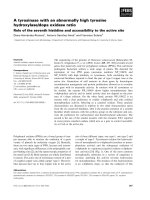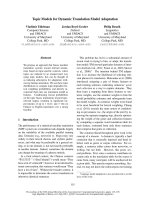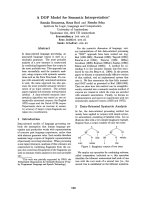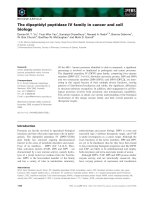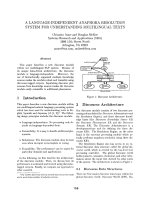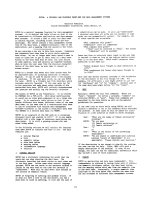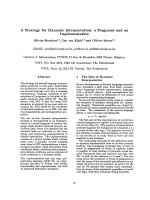Báo cáo khoa học: "A Strategy for Dynamic Interpretation: a Fragment and an Implementation" pot
Bạn đang xem bản rút gọn của tài liệu. Xem và tải ngay bản đầy đủ của tài liệu tại đây (877.49 KB, 10 trang )
A Strategy for Dynamic Interpretation: a Fragment and an
Implementation
Olivier Bouchez 1,2, Jan van Eijck 2,3 and Olivier Istace 1,2
EMAIL: , ,
lInstitut d' Informatique, FUNDP, 61 Rue de Bruxelles, 5000 Narnur, Belgium,
2CWI, P.O. Box 4079, 1009 AB Amsterdam, The Netherlands
3OTS, Trans 10, 3512 JK Utrecht, The Netherlands
Abstract
The strategy for natural language interpre-
tation presented in this paper implements
the dynamics of context change by translat-
ing natural language texts into a meaning
representation language consisting of (de-
scriptions of) programs, in the spirit of dy-
namic predicate logic (DPL) [5]. The dif-
ference with DPL is that the usual DPL
semantics is replaced by an error state se-
mantics [2]. This allows for the treatment
of unbound anaphors, as in DPL, but also
of presuppositions and presupposition pro-
jection.
The use of this dynamic interpretation
strategy is demonstrated in an implemen-
tation of a small fragment of natural lan-
guage which handles unbound pronoun an-
tecedent links, where it is assumed that the
intended links are indicated in the input
string, and uniqueness presuppositions of
definite descriptions. The implementation
consists of a syntax module which outputs
parse trees, a semantic module mapping
parse trees to DPL representations, a repre-
sentation processor which determines truth
conditions, falsity conditions and presuppo-
sition failure conditions, and an evaluator of
these conditions in a database model.
The implementation uses the logic pro-
gramming language GSdel [6], an exper-
imental successor of Prolog, with similar
functionality and expressiveness, but with
an improved declarative semantics.
1 The Idea of Dynamic
Interpretation
Recent developments in Natural Language semantics
have witnessed a shift away from static represen-
tation languages towards representation languages
with a dynamic flavour. Such representation lan-
guages can be viewed as definitions of very simple
imperative programming languages.
To see how the imperative style comes in, consider
the treatment of indefinite descriptions (or: existen-
tial phrases). Existential quantifiers are viewed dy-
namically as random assignment statements followed
by tests. The translation of the natural language
phrase 'a man' becomes something like:
x
:= ?;
man(x)
The first part of this statement can be viewed as a
random assignment to register x, the second part as a
test on the value ofx. This sequence of instructions is
performed against the background of a database, i.e.,
a model of first order logic. The sequence succeeds if
the database contains (representations of) men, and
it can succeed in as many ways as there are men
available in the database.
The motivating examples for the shift from static
to dynamic representation have to do with pronoun
binding. The translation of phrases like 'a man' in
terms of assignments of values to registers makes
it possible to treat binding of pronouns across sen-
tence boundaries (the next sentence can start with
'He' to pick up the reference to 'a man'). The nice
thing about the treatment in terms of assignment is
that the scope of the existential quantification is not
closed off at the end of a sentence, as used to be the
case for NL systems that employ static representa-
tion (in terms of the existential quantifiers of predi-
cate logic, with their irritating closing brackets).
61
Recently, it has become clear that dynamic repre-
sentation has some other interesting features:
• It becomes possible to give an account of pre-
supposition failure phenomena in terms of the
definition of an error state semantics for the dy-
namic representation language [3; 2]. Presuppo-
sition failure occurs for example if one tries to
interpret "John's wife is unhappy" in a situation
where John is not married.
• A more natural treatment of tense becomes pos-
sible. A sequence of sentences in the past tense
like "A man walked in. He sat down. He or-
dered a drink" etc, is represented using subse-
quent assignments of values (time intervals) to
a dedicated time register t [10].
The dynamic representation language can be anal-
ysed with tools that were originally designed
for analysing imperative programming languages,
namely the tools for precondition reasoning from
Itoare logic or dynamic logic [11]. Precondition rea-
soning for dynamic predicate logic with standard se-
mantics was introduced in [4]. Precondition reason-
ing gives the truth conditions of DPL representations
in the form of formulas of first order logic (FOL).
When applied to the error state semantics of DPL,
precondition reasoning can also be used to find the
presupposition failure conditions of DPL representa-
tions as FOL formulas.
We provide an integrated treatment of syntax and
semantics of a small fragment of natural language
and test this by implementing it. The syntax of our
toy grammar is a version of categorial grammar with
feature unification. The semantics uses DPL rep-
resentations, with an error state semantics which is
reflected in the rules for precondition reasoning im-
plemented in the precondition module. This module
generates predicate logical formulas expressing the
weakest preconditions of success, failure or error of
the DPL representations.
In detail, our interpretation strategy consists of
the following steps:
1. Parsing a sentence or text and building a repre-
sentation tree of its structure.
2. Translating the parse tree into a DPL program.
3. Using precondition reasoning to compute pre-
conditions as formulas of FOL.
4. Simplifying the preconditions using a simplifier
for FOL formulas.
5. Evaluating the resulting formulas in a database
model.
The current implementation produces for an input
text within the grammar fragment: a LaTeX form re-
port containing the sentence, the parse tree, the DPL
translation, the precondition of success, the precon-
dition of failure and the precondition of error, all in
simplified form, and the result of evaluation in the
database.
2 Dynamic Predicate Logic
2.1 Informal discussion
DPL meaning representations for natural language
sentences can be viewed as procedures or programs
with a relational semantics. The programs that rep-
resent the meanings are interpreted as relations be-
tween input states and output states. A state is a
mapping from variables to values in a model (in our
simple set-up all variables are of the same type). The
representation for an example sentence such as "John
saw a man" is a program which associates
John
with
a variable
z, a man
with a variable y, and first checks
whether the value of x equals John, next puts a value
in y which satisfies the predicate of being a man, and
finally checks whether the values of z and y are such
that the first saw the second.
Thus, the representation of "John saw a man"
is a program which relates input states where z is
mapped to John to output states where z is mapped
to John and y is mapped to some man seen by John.
If the evaluation takes place in a model where John
saw several men, then there are several possible out-
put states. If the evaluation takes place in a model
where John saw no men at all, then there is no out-
put. A program that yields no output for a given in-
put fails for that input. A program yielding at least
one output for a given input succeeds for that input.
A program which yields at most one output for a
given input is deterministic for that input. A pro-
gram which yields more than one output for a given
input is indeterministic for that input. The example
"John saw a man" shows that indefinite descriptions
may give rise to indeterministic programs. Deter-
ministic programs that do not change their input are
called test programs. If a test program succeeds, its
output equals its input. The sentence "John saw
him" would give rise to a test program. Assuming
that the variable z, y are used for the subject and
object of the sentence, respectively, the program will
succeed for any input with x mapped to John and ~/
mapped to some male individual seen by John. In
this case success means that the output state equals
the input state. The program will fail for any other
input.
All basic programs of DPL are tests; they do not
change their input, and they succeed if the values of
terms are in a specified relation and fail otherwise.
Indeterminism in DPL arises from assignment pro-
grams. The assignment program for an indefinite de-
scription
a man
will assign a new value to a variable
x and succeed for any value of z which is a man.
This is called indefinite assignment. The assignment
program for a definite description
~he manager
gives
a value to a variable if and only if there is only one
possible value in the model under consideration.
Complex programs can be formed by means of
negation, implication and sequential composition.
Negation and implication always form tests, but se-
62
quential composition does not. Sequential composi-
tions are tests if and only if the component programs
are tests.
2.2 Syntax
For ease of exposition we will assume there are no
function symbols in the DPL representation lan-
guage, so the terms of DPL are either constants or
variables. Let C be the set of constants, V the set of
variables, and assume c E C, v E V.
DPL terms t ::= c I v.
Assume a set of relation symbols R with arities.
Then the programs of DPL are given by the following
BNF definition.
DPL programs ~r ::= t = t I Rt t [ Qr;r) [(r ::~
I I v: I,v :
We will use man, see as the relation symbols that
translate "man", "see", and so on. Thus, (1) is a
DPL program.
(1) (T/v2 : man(v2); see(v2, v4)).
We will omit outermost brackets and brackets in
sequential compositions like
((71"1;7i'2);r3).
This is
harmless, for sequential composition is associative.
Also, we will abbreviate r]v : v = t as v := t. This
abbreviation is natural, as the sequential composi-
tion of random assignment to v and test for equality
with t boils down to assigning the value of t to v.
2.3 Indices for Antecedents and Anaphors
In the natural language fragment we treat, we use
co-indexing to indicate intended anaphoric links.
We follow Barwise [1] in using superscripts for an-
tecedents and subscripts for anaphors.
(2) A man walked in. He smiled.
If we intend the pronoun in (2) to refer to the subject
of the first sentence, we indicate this intention as
follows.
(3) A man 1 walked in. He1 smiled.
The superscript on the indefinite noun phrase indi-
cates that this NP acts as an antecedent for NPs
with the same index as a subscript. The subscript
on the pronoun indicates the antecedent to which the
pronoun is linked.
The use of subscripts and superscripts is necessary
because noun phrases can act as anaphors and an-
tecedents at the same time.
(4) A man I walked in.
Another man~ walked ont.
Hez was angry.
In example (4) the noun phrase another man is
anaphorically constrained by an antecedent noun
phrase a man (it must have a different referent), and
at the same time acts as antecedent for the second
occurrence of a man.
The superscripts and subscripts refer to the vari-
ables we employ in the translation of the noun
phrases. Superscripts correspond to variables that
get assigned a value in the translation, subscripts to
variables that are simply used. Sentence (5) will get
translated as (6) (tense is ignored, here and hereafter,
for ease of exposition).
(5) John 1 saw a man 2.
(6) vl := J; : man( 2); see( l,,2).
Sentence (7) gets translated as (8).
(7) Mary 3 ignored himx.
(8) va := M; ignore(va, vl).
Sentence (9) gets translated as (10).
(9) Shea saw another man~.
(10) ~/v4; v4 ¢ v2; man(v4); see(va, v4).
Turning now to definite descriptions, the natural
translation of example (11) is (12).
(11) John I saw the man 2.
(12) vl := J; ~v2 : man(v2); see(vl, v2).
In the error state semantics for DPL that we have in
mind for this, (12) gives error in every model where
there is no unique man. It is clear that in most cases
this is too strong. Still, we do not think this is a
serious problem for our general approach. It seems
to be a linguistic fact that definite descriptions often
are used in a context-dependent way, to designate
a unique referent in a very specific context, which
however is not made fully explicit.
One context where (11) makes perfect sense is a
situation where John and some other male individ-
ual are present, and where it is left implicit that John
is excluded from the context where the reference is
unique. In such cases we propose to read the def-
inite description as uniquely satisfying the descrip-
tion plus the extra condition of being non-identical
with some constraining antecedent, in this case the
subject of the sentence. This strategy boils down to
reading (11) as (13).
(13) John 1 saw the other man~.
Here the determiner the otheri is treated similarly to
anotheri. This gives translation (14).
(14) Vl
:= J; ,v2:(v2 ¢ vi; man(v2));
see(vi,
cases another mechanism seems to be at In many
work.
(15) A man walked in. John saw the man.
Example (15) has a natural reading where the
definite description is anaphorically linked to an
antecedent. We propose to make such implicit
anaphoric links explicit, as in (16).
(16) A man a walked in. John 2 saw the man~.
If we provide the right translation instruction for
such anaphoric uses of the, we arrive at translation
63
(17).
(17) Ovl : man(vl); walk-in(v1); vg~ := J;
/,'03 : (133 = 131;
man(vs)); see(v2, v3).
This gives the man~ the meaning: the unique man
that is equal to vl, with v3 available for later reference
to this individual. It seems to us that this gives the
correct result, in the present case and in lots of other
cases.
In the case of (18) we still run into trouble, how-
ever.
(18) The man with the hat smiled.
Here, the natural translation is (19).
(19) +vx : (man(v1); ,vz : hat(v2); is-of(v2, vl);
smile(v1).
This translation contains a definite assignment ev2 :
hat(v2), so it seems to assume that there is a unique
hat in the domain of discourse, which is perhaps a
bit too strong. There are at least the following two
ways out. One is by handwaving. Just remark that
in descriptions like the man with the golden gun, the
second definite article is not quite as definite as it
looks, and the description is in fact idiomatic for the
more strictly correct the man with a golden gun. The
other escape is to add an epicycle to the analysis, in
order to achieve that man 1 with1 the hat 2 translates
into (20).
(20) man(~)l); t~)2: (hat(I)2)" ~ i8-0f(I;2,1)1) ).
We provisionally opt for the first solution.
2.4 Semantics
The standard DPL semantics maps input states to
sets of possible output states. Let a model .A4 =
(M, II, where M is the domain and I the interpre-
tation function for a set of constants and relation
symbols be Kiven. Then the set of states is the set of
functions M v , and the standard semantics for DPL
is given by a function [.]~ : M V + ~p(MV).
In order to capture the uniqueness presuppositions
of definite descriptions, we replace the standard se-
mantics by an error state semantics. In a Russellian
account of definite descriptions, "The king of France
is bald" when evaluated with respect to the state of
affairs in 1905 or 1993 is false, for there is no unique
referent for the description. But it is much more nat-
ural to follow Frege, Strawson and the majority of the
linguistic community in assuming that statements in-
volving "the king of France", when interpreted with
respect to a state of affairs where there is no unique
king of France, may be neither true nor false, because
they suffer from presupposition failure.
We propose to use an error state semantics to take
in account the failure of uniqueness presuppositions
of t assignments. The error state semantics of DPL
if given by a function
[.].~ : (M e t.J <r) -+- :P(M V 12 e).
In the definition of this function, which follows, e
refers to a special error state, A ranges over proper
states, B ranges over states in general (including the
error state), and A[x := d] is used for the proper
state which is like A, except for the fact that z is
mapped to d.
1. [xl.~l(e) = {c}
2. [Rta tn].~(A)=
{A} if (V~,a(tl), V.~,a(tn)) E I(R)
0 otherwise.
3. [t~ = t2].~(A) =
{A} if Vdbl,A('l)
~-
V.I~,A('2)
0 otherwise.
4. [(~1; ~2)]~(a) =
s. [(~, ~ ~)|~(a) =
/ {~} if there is a state B E [a'l]~(A)
with[lr2]~(B) = {c}
{A} if for all B e [~II~(A)
it holds that[a'2]~(B) • {e)
otherwise.
6. [('~x]~a(A) =
{e} if [a']~(A) = {e}
{A} if [Tr],~(A) = $
O otherwise.
7. [,lx: ,~]~(A) =
U{[-]~(A[z := d])ld e A4}.
s. [,,x:.l~CA) =
{ [x]~(A[z := d]) for the unique d with
[x]~(A[z := d]) g {e}
if d exists
{e} otherwise.
More information on this definition can be found in
[2]. For present purposes it is sufficient to note that
a DPL program can execute in three different ways,
when acting on a given input state:
1. The program reports success by producing at
least one proper output state. For example, the
program man(vx) when acting on an input state
where Vl refers to John will succeed and return
the input state as its only output state.
2. The program reports failure by not producing
any output at all. For example, the program
rlvl : woman(v1) will fail for any input state
(except e) if there are no women in the model
under consideration (its output state set will be
empty).
3. The program reports error by producing e as its
only output. For example, the program ,.vl :
manager(v1) will produce e for any input state
if the model under consideration does not have
a unique manager.
64
3 Preconditions of DPL programs
Above, we have referred to DPL formulas as pro-
grams. We are now going to use tools for program-
ming language analysis on DPL. We will use quan-
tified dynamic logic over DPL to describe the pre-
conditions for success, failure and error of DPL pro-
grams.
QDL terms t ::= c I v,
qDLprograms lr ::=
t = t ] Rt t I
Or; It) ]
QDLformulas ~::=t tIRt tl(~A~)l ~l
Note that the QDL programs are precisely the DPL
programs. An atomic relation
Rtl, , tn
can occur
inside a QDL program or as an atomic QDL formula,
so we need to distinguish the programs of QDL from
the static QDL relations. We use boldface for the
test program
Rt~ tn
and italics for the formula
Rt t t~.
We omit outermost parentheses as usual, and use
T for a formula which is always true, I for a formula
which is always false.
The semantics of QDL is as for first order logic,
with the following clauses for the program modalities
added (assume A ~ e):
• A4 ~A (~')~ iff there is some B with B E
[Tr]]~a(A), B ¢ e and .44 ~B 9.
• A4 ~A [lr]~ iff for all S e Iris(A) it holds
that B # e and .44 ~ 9-
Note that (~r) and [~r] are not duals. (~')T expresses
the conditions for success of ~r, [~-].L the conditions
for failure of z. It follows that ~(~r)T A [~r].l_ ex-
presses the conditions for error.
The following axiom schemata can be used to com-
pute these conditions as formulas of FOL.
1. (Rt, t,,)~ ~ (ntt t, A ~).
2. [Rt, t,]to ~ (Rtt tn -~ 9).
~.
(t, = t,)~, ~ (t~ = t~ ^ 9).
4. It, = t~]~, ~ (t~ = t~ 9)-
6. [~, ;~:~]~ ~ [~,][~]~.
7.
(-,~)~ ~
(~, ^ [~]±).
8. [-~-]~, ~ ((~)-r v
(~, ^
[~-]±)).
10. [~r, =~
~r,]~ ~ (([~',]((~r,)T V [~r,]J_)) A
([~r,](~,)T ~ 9))-
11. (n,,: ,r)~, ~. a~,(,,-)~,.
12. Nv: ~r]~# Vv[vr]~.
14. [,,,: ~-]~, ~ (a!v(~-)T ^ V,,((~-)T + [~-]~)).
The most interesting item of this list is the univer-
sal schema for t assignment (item 14). To see what
it means, note that [~r]m expresses that all output
states of ~r are proper. The schema states that the
following are equivalent:
• For proper input state A, the program tv : lr
does only have proper output states, and all of
these satisfy ~a.
• For proper input state A there is precisely one
d E M for which 7r has a proper output on input
A[v
:- d], and for all d' for which ~r has proper
outputs on
A[v :=
d'], all outputs of lr on
A[v :=
d'] are proper and satisfy 9.
It is not very difficult to see that these are indeed
equivalent, so the axiom schema is sound, as are the
other axiom schemata.
The axiom schemata can be used to calculate the
truth, falsity and error conditions of DPL programs
as formulas of FOL. If we represent a first order
model as a database, then evaluation of DPL in a
model reduces to evaluation of first order formulas
in the database.
An example will make clear how the axioms may
be used to compute preconditions of DPL programs
as FOL formulas. Consider example (21) with trans-
lation (22).
(21)
If a woman is married,
her husband looks after her.
(22) (qx :
Wx; Mx) =~
(~y:
gyx; Lyx).
Here is the derivation of the truth conditions.
((rlz : Wa~; Mz) =~ (ty:
Hyz;
Lyx))T
4-~ [~x:
Wx; Mx](~y : ttyx; Lyx)T
~-+ [rlx:
Wx][Mz](*y :
I'lyz)(Ly~)T
~-* Vx[Wx][Mx](Ly :
Hyx}(Lyx)T
Vx(Wx ~
(Mx -~
(:JIy(I-Iy~c)-t- A By(I-Iyx)(Lyx)T)))
,-, Vx(W2: * (Mx
(3!yH~ ^ 3y(Hy~ ^ Lye)))).
To calculate the falsity conditions, we can use
theorem (23), which is derivable from the axiom
schemata:
Applying theorem (23), we get the following falsity
conditions for (22):
3x(Wx
A
Mx
A
3!yHyx A Vy(Hyx ~ -~Lyx)).
Program (22) aborts with error if it doesn't succeed
and doesn't fail. Modulo some FOL reasoning the
conditions for this are given by (24):
(24)
3x(Wx
A
Mx
A
-,d!yYyx).
This means that in all models where married women
do have unique husbands, program (22) will never
abort with error. In other words, the calculus allows
us to derive that the presupposition of the definite
description has been cancelled by the implication.
65
4 The Implementation
The parser The grammar for our fragment uses
categorial feature unification, and the parser is based
on standard techniques for such grammars. The syn-
tax consists of a lexicon, which associates categories
with lexical items, a category descriptor which gives
definitions of complex categories in terms of simpler
categories and some reduction rules.
Basic categories are S without features, and E
with features for number, person, case,
uindez
for
up index (= antecedent index) and
dindex
for down
index (= anaphor index). Complex categories are
built with / and \ and the constraints on feature uni-
fication in the usual way. The index features
uindez
and
dindez
also occur on noun phrases and determin-
ers. Here are some examples of complex categories
(, marks the feature values that do not matter).
• N(number) =
S/E(number,*,*,*).
• NP(number,person,case,uindex,dindex) =
S/(E(number,person,case,uindex,dindex) kS).
• VP(number,person,*) =
E(number,person,Nom,*,*)\S.
• TV(number,person,tense) =
VP(*,*,tense)/NP(*,*,Acc,*,*).
• DET(number,uindex,dindex) =
NP(number,Third,*,uindex,dindex)/
N(number).
• AUX(number,person) -
VP(number,person,Tensed)/
VP (number ,person ,In f).
• NEG =
AUX(number,person)\AUX(number,person).
Basic categories get assigned in the lexicon. For ex-
ample:
word Category
John ~ NP(Sg,Third,*,i,*)
hei NP(Sg,Third,Nom,*,i)
himi NP(Sg,Third,Acc,*,i)
sees TV(Sg,Third,Tensed)
a i DET(Sg,i,*)
the i DET(*,i,*)
another~ DET(*,i~i)
his} DET(*,ij)
man N(Sg)
with (N(nr)kN(nr))/NP(*,*,*,*,*)
Some examples of complex category formation:
• a man;:
DET(Sg,i,*). N(Sg) =
NP(Sg,Third,*,i,*)/N(Sg). N(Sg) =
NP(Sg,Third,*,i,*).
• sees a man*:
TV(Sg, Third, Tensed) • NP(Sg,Whird,*,*,*)
= (VP(Sg,Third,Tensed)/
NP(Sg,Third,Acc,*,*,*))
-NP(Sg,Third,*,*,*)
= VP(Sg,Third,Tensed).
•
John~ sees a mani:
NP(Sg,Third,*j,*)- VP(Sg,Third,Tensed) -
(S/(E(Sg,Third,* j,*)kS))-
(E(Sg,Third,Nom,*,*)\S)
mS.
The translator The translator uses A-calculus to
translate parse trees into DPL programs• We could
have translated on the fly, building translations while
parsing, but the present set-up seemed preferable for
reasons of modularity of design.
The translation algorithm makes use of a lexical
function mapping pairs consisting of a lexical item
with an associated category to A-expressions in the
lexicon, along the lines of [9].
Translating a sentence into DPL boils down to
lambda reduction of the lambda expression which
results from combining the lambda expressions as-
sociated with the leaves of the parse tree, according
to the rules of functional application dictated by the
categorial structure.
Here are some examples of lambda expressions as-
sociated with lexical items with categories. Note that
we assume the presence of indices in the lexicon, so
we can handle anaphoric links by co-indexing.
For a proper understanding of the translation in-
structions one should bear in mind the distinction
between DPL variables that are used for DPL assign-
ment and lambda calculus variables. We use lower
case for the first and upper case for the latter.
Translation for
man,
N(Sg):
AVl.m (VI).
Translation for
John i,NP(Sg,Third,*,i,*):
AVl.vi := J;
Vi(v,).
Translation for sees, TV(Sg,Third,Tensed):
A VI.( A V2.(Vl A V3.see(V2,
V3))).
Translation for
is,
TV(Sg,Third,Tensed):
A VI .( A V2.(Vl A Vs. V2
=
v3)).
Translation for
a(n) i,
Det(Sg,i,*):
AV~.(AV2.(,lv, : VlO,,);
V2(,,))).
Translation for
the i,
Det(*,i,*):
AVI.(AV~.(~,,,:
V,(v,); V~(v,))).
Translation for
the~,
Det(*,ij) (the anaphoric use of
the):
AVI.(AV2.~v,
: (v, = vi; VlV,); v2(,,)).
Translation for
if,
(S/S)/S:
A VI ,( A V2. V, =~ v~ ).
Translation for
does,
AUX(Sg,Third):
AVI.V1.
66
Translation for
not,
NEG:
~ v~ . ( ~ v~ . -, ( v~ v~ ) ) .
Translation for
another,
DET(Sg,i,j):
~Vl.(~v~.(,~v~
: ,~ # v~; v](~); V~(vd)).
Translation for the other, DET(*,i~):
~Vl.(~V~.(~,~
: (.~ # ~; V~(v~)); V~(~d)).
Translation for he/, NP(Sg,Third,Nom,*,i):
~v~.v,(~,).
Translation for
hisS,
DET(*,ij):
~v~.(~v~.,v~ : Vl(,d; iso/(,~, ~); V2(vd).
Translation for with, (N(nr)\N(nr))/NP(*,*,*,*,*):
~ v~.( ~ v2.( ~ v~.( v~(v~); Vl ( ~ ¼ ~of ( V~,
v3)))).
All these translations are typed, but we have left
most of the typing discipline implicit. For example,
the translations of noun phrases all are of the type
of (dynamic) generalized quantifiers, which take a
property to give a DPL program. The translation
of proper names is a dynamic variation of the Mon-
tague treatment for proper names [8]. In extensional
Montague grammar, proper names translate into ex-
pressions denoting the set of properties which are
true of the named individual. Here, proper names
translate into expressions that for every property
give the DPL program which first assigns the name
of the individual to the index variable of the proper
name, and then tests for the property. This is like
in Montague grammar, but with a dynamic touch
added. Anaphoric links to the name remain possible
by means of the index variable as long as its value
remains unchanged.
Other noun phrases with a dynamic flavour are
indefinite and definite descriptions. Indefinite de-
scriptions translate into expressions that for every
property give the DPL program which does an in-
definite assignment to an index variable and tests
for the property. Definite descriptions are handled
likewise, but with definite assignment instead of in-
definite assignment.
(25)
John x uses his pc~.
As an example, we treat the translation of (25),
which is obtained starting from the following parse
tree:
(S,
(NP 1, John) ,
(yP,
(TV,
u~e~),
(NP?,
(DET~,his),
(N, pc)
)
The translation step by step:
his pc~ ~ AVI.()W~.tv2
:
y~ (v2); i8-o/(v2, ,1); y2(,2))(~v~ .pc(V1))
* b
;w2.,v2
: pc(v2);
is-of(v2,
v0; v2(~2).
uses his pc~
)~ V~ . ( )W2 . V, ( ), Vs . use ( V2 ,113 ) ) )
(~v2.~v2 : pc(v2);
i~-of(~2,
v0; v2(v2))
'4"
~v2.(~v2.(~
: pc(~2);
i~-of(v2,
~);
V2(v2))
(aV3.use(V~, V,))
(AV~.tv2 :
pc(v2); is-of(v~.,
vl);
(AVa.use(V2, Vs))(v2))
~v2.,v2 : p~(v2); is-of(,2,,1); use(V2, ~2).
John 1 uses his pc~
(~Vl.v~ := J; (vdvl))
~V2.,v2
: ~c(v~);
i~.of(v~,
v~);
use(V2, v~)
, +
v~ := J;
(AVz .tv2:
pc(v2); is-of(vg.,
Vl);
use(V~,
vg.))(vl)
4
Vl := J; ~ : ~c(v~);
is-of(~,
~1); use(~x, v~).
In the same way, (26) gets translated into (27).
(26)
John 1 is a man ~.
(27) vl := J; ~/v2 :
man(v2); Vl = v2.
Note that 'is' is treated as in Montague grammar [8].
5 Experiences with the GSdel
Implementation Language
The declarative semantics of GSdel improves on the
semantics of Prolog: extra-logical Predicates (such as
vat, nonvar, assert, retract,
! ) are avoided and
sometimes replaced by declarative counterparts.
Like Lambda Prolog [7], GSdel is a typed language:
it is necessary to declare the type and domain of all
functions and predicates (polymorphism is allowed,
however). This convention makes program writing a
bit more cumbersome, For example, we have to de-
clare the type Program for representing a DPL pro-
gram. For each DPL statement, it is necessary to
define a function to build a Program (example: Pi-
ota : Variable * Program ~ Program). We also have
to declare a type Expression for A-expressions. Some
complications arise from the fact that an expression
may contain a DPL program and vice versa. On the
plus side, more errors are detected during compila-
tion, the compiler generates more efficient code, and
the typing discipline makes for more legible, com-
prehensible programs. Last but not least, the typing
discipline has obliged us to think a bit more about
the clauses we were writing than we perhaps would
have done otherwise.
67
GSdel has facilities that permit elegant meta-
programming. In Prolog the program and the meta-
program are not independent: the predicates as-
sert and retract modify the program itself in which
these predicates occur. In GSdel, program and meta-
program are completely independent. It is possible
for a program to load another program, to modify
this other program by inserting or retracting predi-
cates, functions or types, and to demonstrate a goal.
In our implementation we use these facilities to rep-
resent a model as a logic database and a precondition
as a complex goal.
6 The Program Itself
The main module takes a sentence or text as input
and produces a report containing the sentence, the
parse tree, the DPL program it gets translated into,
and the preconditions. This module uses the follow-
ing submodules:
• the parser module which from a sentence, finds
its category and builds its parse tree,
• the translation module which from the parse
tree, computes a representation of a DPL pro-
gram,
• the precondition module which from a DPL pro-
gram, derives the preconditions (this module
calls another module to simplify the resulting
FOL formulas),
• the evaluation module which performs a
database evaluation.
A lexicon module is called by the first two of these
modules. It contains the words, with their categories
and the associated A-expressions.
6.1 Main module
This module receives a sentence represented by a list
of words and parses it, translates it, produces a re-
port, computes preconditions and evaluates these in
a given model.
6.2 Output
This module defines how to output programs, ex-
pressions, categories, trees, words, It uses the
facilities of GSdel for manipulating text files.
6.3 Lexicon
The lexicon is defined by a predicate Diet with three
arguments: the word itself, a category and an appro-
priate lambda expression.
6.4
Parser
The parser employs backtracking and unification in
the usual way. GSdel (as all logic programming lan-
guages) has these features built in, which makes it
very easy to implement a parser for a simple frag-
ment like ours. The parsing of a sentence consists of
three steps:
* generate a list of categories corresponding to the
sequence of words,
• reduce the list of categories,
• test if you have a sentence else retrace your steps
and try again.
We use the type categor to represent categories. It
is defined by the constant S and the functions
E(nnmber, person, case, nindex, dindez),
NP (number, person, case, uindex, dindex),
N(number),
and so on. The two infix functions / and \ serve to
build new and more complex categories.
Sentences axe parsed by building a binary parse tree
in bottom-up fashion. The binary parse trees are
represented by a constant Empty and a function A.
Empty represents the empty tree and the function
A gives the information at the current node, the left
subtree, and the right subtree. The information con-
tent of the nodes is of two kinds: internal nodes carry
the result of combining the categories of the subtrees
and leaf nodes carry a pair consisting of a word and
its category.
The parse trees are built during the reduction of the
list of categories, starting with a list of trees corre-
sponding to the words of the sentence. When we
reduce two adjacent categories, we replace the two
corresponding trees T1, 7"2 by a single tree with T1
and Tz as immediate subtrees.
6.5 Translator
The translator uses two types: Program and Ezpres-
sion. The first represents a DPL-program, the sec-
ond a complex A-expression. We have left the rest of
the typing of the lambda expressions implicit.
The definition of programs and lambda expressions
is a bit cumbersome, for a A-expression may contain
a program and vice versa. This complication is re-
flected in the rules for substitution and reduction.
For example, it is necessary to define the substitu-
tion of an expression for a variable in a program, the
free occurrence of a variable in a program, etc. The
rules of reduction are a straightforward rendering of
the rules of ~-reduction and 7-reduction in A calcu-
lus. We
do not
handle a reduction, as we see no need
for variable renaming.
The translation process employs the following pred-
icates:
Trad
This predicate translates a parse tree into a
reduced A-expression. Depending on the information
at the current node of the parse tree, a lexical look-
up of the translation takes place, or the translation is
found by reducing the application of the translations
of the left and right subtrees.
Trans This predicate translates a list of parse trees
for the sentences of a text into the corresponding
68
DPL program. It uses the predicate
Trad
to trans-
late each sentence, and then links these translations
by applications.
Canted This predicates takes a h-expression and
reduces it using the declarative functional semantics
of h-calculus.
6.6 From DPL to QDL
We have seen that DPL programs are represented
as G6del functions. The reduction of DPL to FOL
by means of QDL gets implemented by defining re-
duction predicates corresponding to the QDL axiom
schemata. These predicates call each other recur-
sively.
• Fa(Rei(s,v)) is a relational atomic test.
(at1 t.)
• Fequal(tl, t2) is an atomic test of equality of
the terms tl and t2. (tl = t2)
• Fand(phil, phi2) is the conjunction of two for-
mulls. (~1 A ta2)
• For(phil, phi2) is the disjunction of two for-
mulls. (~1 V ta2)
• Fimplie(phl,phi2)is the implication of two
formulas. (ill * ta2)
• Fall(V(i), phi) is the expression (Vvi~)
• Fexist(V(i), phi) is the expression
(3vita)
• Fonlyone(V(1), phi) is the expression (q!vi~)
• Fnot(phi) is the negation of the formula ta.
• Fpreeexist(pi, phi)is the expression ((~r)ta)
• Fprecuniv(pi, phi)is the expression ([~r]ia)
• Fpar(pi, phi) is the expression (-~(Tr)taA-~[Tr]~).
In the course of applying these predicates, formulas
may get generated with obvious redundancies. We
have defined a formula simplifier to remove some of
these. This improves the readability of the output
(the formulas are output in LaTeX format) and the
performance of the database lookup on the basis of
the conditions.
There is the list of simplifications handled by the
module
Simple.
• ~# A T +-~ ~#
• ~# A.L +-+ J-
• ~VT~T
• ~ V-L ~-~ ~
• (~T)~T
• (T*-
• (_I_ *- ~) ~-~ T
• -~T ~ _L
• (3!v~ A =Ivy,) ~ :l!v~.
6.7 Evaluation
The intermediate language QDL allows us to trans-
late DPL programs into formulas of FOL. These are
then evaluated in a database model, i.e., a first order
model which is implemented as a G6del database (a
G6del program). There we have a so-cMled meta-
module
Evaluation
and an object program
Logic
Database,
and the meta-program manipulates the
object program. We translate first order conditions
into G6del goals, and then apply the goal to the ob-
ject G6del program, using the possibilities of meta-
programming offered by G6del. In ordinary Prolog,
these things could also be done, but they would look
much less elegant.
Here is an example of a Gfdel model (the lines pre-
ceded by % are comment lines):
MODULE Model1.
IMPORT Strings, Sets.
BASE Symbol.
% We use this base for every kind of term.
CONSTANT
John, Bill, Freddy, Borsalino, Myclone: Symbol.
PROPOSITION Top.
PREDICATE
Admire, Cheer, Isof, See, Use : Symbol * Symbol;
tilt, Man, Adult, King, Pc, Manager : Symbol.
% The relations defined in the model
Admire(John,Bill).
King(Bill).
Isof(Borsalino,Bill).
ttat(Borsalino).
See(John,Bill).
See(Bill,John).
Manager(Bill).
Man(John).
Man(Bill).
Man(Freddy).
Adult(John).
Adult(Bill).
Pc(Myelone).
Use(John,Myclone).
Top.
% Top must be defined in every model.
69
7 Conclusion
The QDL translation discussed above only handles
uniqueness presuppositions of definite descriptions.
The method employed is general enough, however,
to handle lots of other kinds of presupposition. Lex-
teal presuppositions, for example, are handled in the
error state semantics by a slight revision of the se-
mantic clause for atomic tests. Being a bachelor pre-
supposes being male and adult, so the test for bach-
elorhood should give error if it is performed on an
entity that does not satisfy the test for being a male
adult.
Formally, the revision boils down to this. Let At be
the set of atomic formulae of DPL. Assume a lexi-
cat presupposition function lp :
At ~ DPL
mapping
each atomic test predicate of the representation lan-
guage to its associated lexical presupposition, con-
ceived as a program of the representation language.
For example, here are the lexical presuppositions for
bachelorhood.
lp(bachelor x) = (male x; adult x).
The semantic clause for atomic relations is mod-
ified to take the function lp into account:
2'. [R(tx ~.)]~(A) =
{A} if
~lp(Rtl t,)]~(A) q~
{e}
and A4 ~A
Rta tn,
0
if [lp(Rtl
t,)]~(A) 9~
{'}
and
.~4 ~A Rta t,~,
{,} if ~lp(Rtl t,)]~(A) C_ {,}.
This modified definition gives the success and failure
of the relational test modulo the fact that the lexi-
cal presupposition of the relational test holds; if the
presupposition does not hold then the test results in
error.
There is no need for any other changes in the rules,
for the projection of lexical presupposition is taken
care of by the general principles of error percola-
tion that are already implicit in the semantic clauses.
Thus, the DPL error semantics gives us that (28) pre-
supposes that Jan is male and adult, but that (29)
only presupposes that Jan is adult.
(28)
Jan is a bachelor.
(29)
If Jan 1 is male, then hel is a bachelor.
The change in the semantic clause for atomic re-
lations is reflected in the calculus by replacing the
schemata for
Rtl tn
by the following versions:
1. (Rtl tn)~a ~-+
(Rtl
t,, A (p A (lp(Rt~ • • • tn))r).
2. [Rtl tn]~ *-+
( Rtl . . . t.
+ ~)
^
(lp(m~ • tn))r).
In the implementation, lexical presupposition is han-
dled by a predicate
Lp
and a modification of the
reduction predicates for the relational test axiom
schemata.
Right now, we are extending the fragment to deal
with other kinds of presupposition failure, in partic-
ular failure of presupposition of aspectual verbs such
as start
and
stop.
References
[1] J. Barwise. Noun phrases, generalized quanti-
tiers and anaphora. In P. G~rdenfors, editor,
Generalized Quantifiers: linguistic and logical
approaches,
pages 1-30. D. Reidel Publishing
Company, Dordrecht, 1987.
[2] J. van Eijck. The dynamics of description.
Jour-
nal of Semantics,
10, 1993. to appear.
[3] J. van Eijck. Presupposition failure a comedy
of errors. Manuscript, CWI, Amsterdam, 1993.
[4] J. van Eijck and F.J. de Vries. Dynamic in-
terpretation and Hoare deduction.
Journal of
Logic, Language, and Information,
1:1-44, 1992.
[5] J. Groenendijk and M. Stokhof. Dynamic pred-
icate logic.
Linguistics and Philosophy,
14:39-
100, 1991.
[6] P.M. Hill and J.W. Lloyd. The GSdel report.
Technical report, Department of Computer Sci-
ence, University of Bristol, Bristol, 1991 (re-
vised 1992).
[7] D.A. Miller. A logic programming language with
lambda abstraction, function variables and sim-
ple unification. In P. Schroeder-Heister, edi-
tor,
Eztensions of Logic Programming.
Springer,
1990.
[8] R. Montague. The proper treatment of quantifi-
cation in ordinary english. In J. Hintikka e.a.,
editor,
Approaches to Natural Language,
pages
221-242. Reidel, 1973.
[9] R. Muskens. Anaphora and the logic of change.
In J. van Eijck, editor,
Logics in AI / Eu-
ropean Workshop JELIA '90 / Amsterdam,
The Netherlands, September 1990 / Proceed-
ings,
Lecture Notes in Artificial Intelligence 478,
pages 412-427. Springer Verlag, 1991.
[10] R. Muskens. Tense and the logic of change.
Manuscript, University of Tilburg, 1992.
[11] V. Pratt. Semantical considerations on Floyd-
Honre logic.
Proceedings 17th IEEE
Symposium
on Foundations of Computer Science,
pages
109-121,
1976.
70
